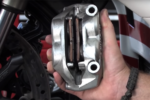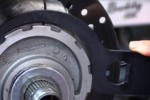Should You Work On Your Own Motorcycle

Doing the maintenance on your own motorcycle can be very rewarding. It allows you to understand your bike better, and it helps you understand why something fails and what could be the culprit, plus you gain a more intimate understanding of your bike. Talk to anybody who has done a lot of maintenance or customized their bike. They talk about their bikes completely differently. As though they were talking about a close friend. Contrast to the way someone who buys off the showroom floor and does nothing more but ride it (not that there is anything wrong with that).
There are a slew of tasks that most at home mechanics can do themselves. However, the key to success is three key points that my father gave to me in my youth.
Know Your Limits.
Embarking on a job that you are not sure how to do can lead to problems quickly. Never be afraid to admit failure and take your bike to a certified motorcycle mechanic. On the same hand, many jobs look very intimidating while the actual task can be quite simple.
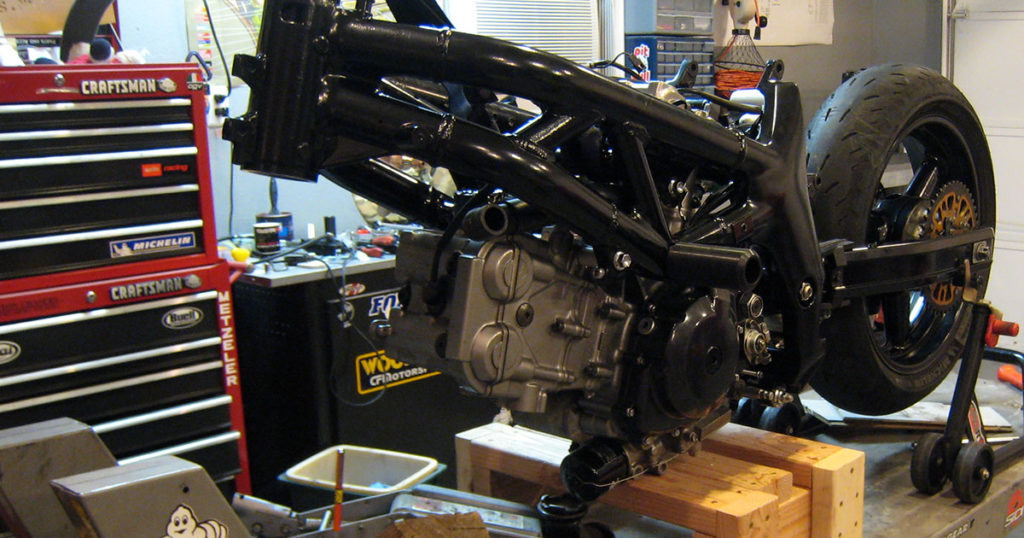
The first time I installed a jet kit, I was reluctant to attempt this on my own. But now, jet kits pose no problem. I felt this same anxiety when it was time to adjust Ducat 2V desmo valves – but that too, turned out to be much easier than I expected.
Take Your Time
This is a big one. Avoid the temptation to rush through a job. As soon as you get into a hurry, you will start to skip steps and find yourself making mistakes or in over your head. To help this, you should multiply the time you think it’s going to take by a factor of four. So, if you think it should take about 60 minutes to to a particular task, allot four hours. This will give you time to setup, clean and up as well as give you time to deal with any unexpected challenges that arise.
Do Not Force Anything
There are few components on a motorcycle that require force to remove or install. If something is reluctant to move, you’ve missed something. Stop what you are doing and back up. There is probably a small fastener that you overlooked that is holding the whole thing together. I once saw a fellow who managed to destroy his engine when he got frustrated and tried to pry it apart with a crowbar. If he would have looked a little closer he would have noticed that he missed one bolt that was buried below the cam.
But, before you decide to do your own maintenance there are a few things you should have in hand and a few things we’ve picked up over the years that make life in the garage a lot easier:
Tools
Have good assortment of metric wrenches, sockets, and screwdrivers. The bigger the assortment the better. When you don’t have the proper tool, go out and buy it even if it is a very specialized tool. You’ll use it again. If it’s a tool that you will use a lot, go the extra mile and get the one with a lifetime warranty. If it’s a tool that will be used very infrequently, go to Harbor Freight and get it. No lifetime warranty, but if you rarely use it, it will probably last your lifetime.
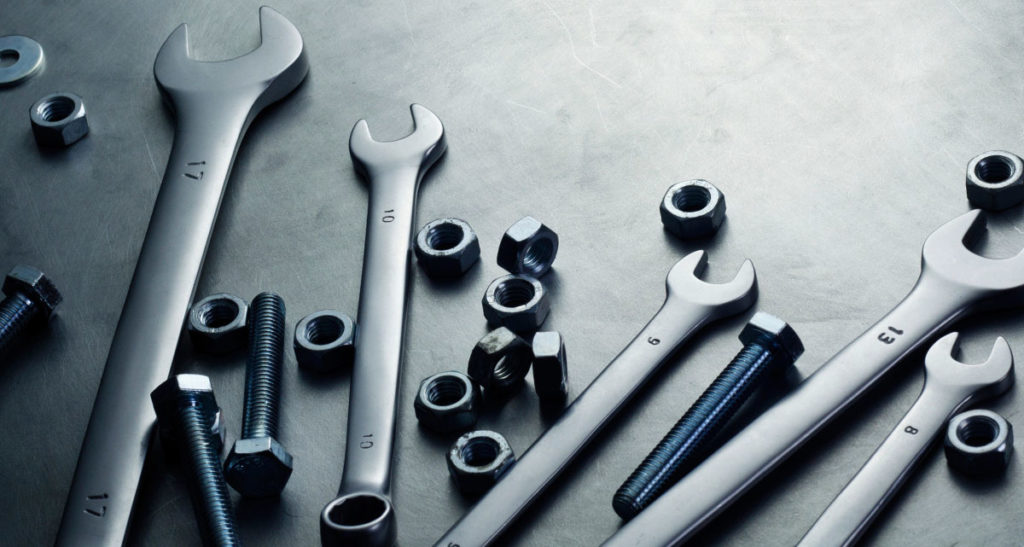
We’ve listed tools individually so you can pick and choose the items you may need, but if you are new to working on your bike, simply purchasing a Craftsman Tool Set is a tremendous value.
Service Manuals
We prefer Factory Service Manuals. The ones produced by Honda, Suzuki, Ducati or whomever. These will give you all the information you need to do any task you can think of. It is the same manual that the pros use. But be aware, some of these run up to $100 in price. And not all factory manuals are created equal. Some work best when used in conjunction with a Haynes manual.
Torque Wrench
These allow you to very accurately set exactly how tight you should snug a bolt. Your shop manual will have these specs for you. It will specify that your spark plugs should be torqued to 8 ft.lbs (example) while your caliper bolts should be torqued to 23 ft. lbs. It ensures that bolts are as tight as they need to be without risking stripping threads. However, not all torque wrenches are created equal. Be willing to spend a little extra to get a good one. You will ultimately need three different ones. A 3/8s drive will do the majority of the work, but a 1/2 drive will be needed for the big stuff. Finally, an inch-pound torque wrench is great for the delicate jobs. If you can only buy one, get the 3/8ths drive. Its the one that will get used the most.
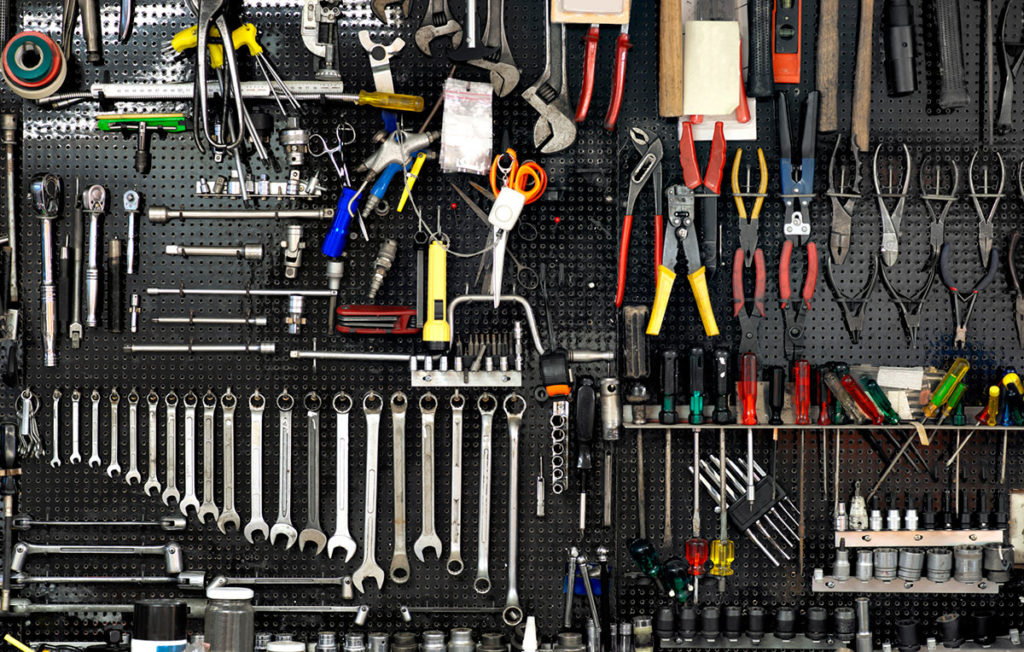
I bought my current one at Sears and it is one of the best values as far as torque wrenches. Also, remember to park your torque wrench at the lowest reading (i.e. 10 ft.lbs.)before putting it away and never, ever, ever tighten past where the wrench clicks. This ensures that it will remain accurate for years to come. (Also, dropping torque wrenches or using them to loosen bolts can ruin them).
You’ll use a 3/8″ Inch Torque wrench the most, but a smaller inch-pound torque wrench is invaluable for the small nuts and bolts.
Sockets
Sockets are the things you’ll be using the most. Traditional sockets come in two styles; 12-point or 6-point. We strongly, strongly encourage you to opt for the 6-point style. They are far less likely to round off your bolts.
A metric hex socket set will be of great value to you. It seems like most things on modern sport bikes are attached with hex-head bolts. This allows for much more efficiency, control and fewer chances of scratching things using the traditional allen wrench. And for only $28 you can’t go wrong. I find these little guys get used more than any other tool in my toolbox. You can attach them to screwdrivers or even T-handles for quicker use. If own a Triumph, you’ll also need a Torx set.
We’ve been using these very same Craftsman sets since the late 90’s;
- Craftsman Metric Hex Set »
- Craftsman 6-Point Metric Socket Set »
- Craftsman 6-Point Deep Metric Socket Set »
Our favorite way to keep our sockets organized is with a “Socket Rack.” That way you can grab all the sockets you need and take them over to your project, and you can tell at a glance if you’ve misplaced a socket.
And finally, lets face it, sometimes bolts and allen’s will get stripped or damaged beyond the point of easy removal. And sometimes threads get gunked up and damaged. Craftsman makes a great bolt extractor kit that has saved our bacon more than once, and a cheap metric tap-and-die kit is awesome for chasing dirty or gunky threads. Just don’t expect an entry-level tap-and-die set to do heavy jobs. We primarilly use these for cleaning existing threads – not cutting new ones.
Drivers
Of course you are going to want a compliment of ratchets. You’ll need a 3/8″ Drive ratchet, as well as big, burly 1/2″ ratchet, along with a compliment of different length extentions and swivels for getting into those hard to reach places. But one of the tools we just can’t live without is called a “Slide-Bar T-Handle.” It basically turns any extenion and socket into a t-handle. We also love our Flex-Head ratchets for squeezing into tight spaces.
- Craftsman 3/8″ Ratchet »
- Craftsman 1/2″ Ratchet »
- Craftsman 1/4″ Ratchet »
- 3/8″ Slide Bar T-Handle »
- Craftsman 3/8″ Drive Flex Head Ratchet »
- Craftsman 10-Piece Accessory Set (Swivels, Extensions and Adapters) »
Wrenches
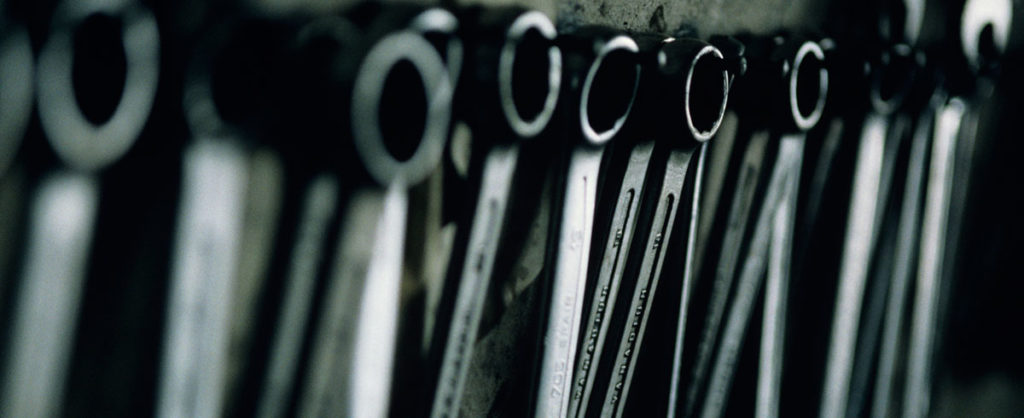
You’ll need a set of wrenches, and we like to have three or four 10mm, 12mm and 14mm to draw from. A set of ratcheting wrenches is also a great time saver, however we avoid the ones that are “switchable” as we’ve had them fail at a higher frequency than the simplery ones that you just flip over to turn the bolt the other direction. We’ve been extremely happy with this set from Stanley. Plus a set of cheap “Giant” wrenches are brilliant for things like axel bolts.
- Craftsman 12-Piece Metric Combination Wrenches »
- Stanley Ratcheting Metric Wrench Set »
- Jumbo Metric Combination Wrench Set »
T-Handles
A quality set of Hex T-Handles are the staple of most every garage. But a word to the wise, cheap Hex-Keys will bar and beat up your allen bolts in short order. Whats more, while Ball-End Hex Keys are fantastic for hard to reach bolts, their use should be avoided beacause these do the most damage to bolts. Always try to use a standard end Hex-Key first to keep allen-bolts from getting bored out or stripped. Allen makes a set where the long side uses a ball-end and the short side is a standard end. Performanc Tool Makes a Set where both ends are standard. We have both sets, but use the non-ball-end set the most by a good margin.
Impact Driver
An impact driver is basically a big screwdriver that ratchets when you hit it with a hammer. You use it when a screw is starting to strip because it’s too tight to get it off with a conventional screwdriver. Because you use a hammer to make it turn, there is plenty of pressure on the head of the screw. While I, hopefully, never have to use it, these things have saved the day for me many times.
Loctite or Threadlock
You’ll want this when you start putting things back together. Avoid using the RED Loctite. Red is permanent and used for internal engine components while the BLUE is used on almost everything else. Your service manual will explain where Loctite should be used. You can get Loctite just about anywhere, including most auto parts stores or Amazon.
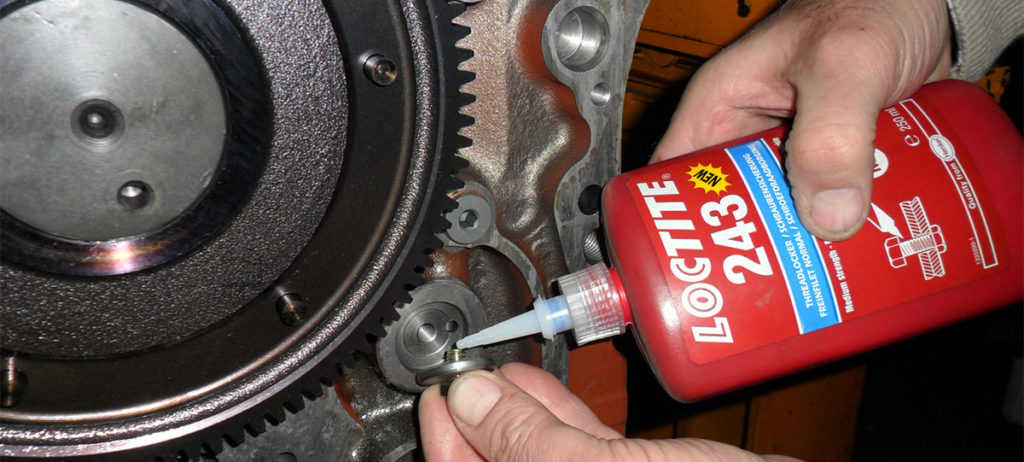
Loctite now comes in all sorts of different flavors, from gel, to stick (like chapstick) to the traditional liquid form. We probably use the Gel most. And a little bit goes a long way. Be careful not to overdue it with Locktit – a li’l dab’ll do ya’.
Also, there is a intermediate strength threadlock that is green in color and a super-forever-permanant version that is black in color.
- Loctite Blue 246 Liquid »
- Blue 248 “QuickStix” »
- Permatex 240 Blue Gel »
- Red Red 272 Liquid »
- Red 377 “QuickStix” »
- Permatex 270 Red Gel »
Anti-Seize
This stuff is amazing when it comes to motorcycles. This blend of ultra-highly refined aluminum, copper and graphite lubricant is designed to keep spark plugs from getting seized into aluminum heads. It is also fantastic for any bolt that goes into aluminum and as we all know, aluminum is extremely common on modern motorcycles.
We use this stuff on just about everything that may get stuck, like bolts that thread into the plastic tank, clutch and brake lever pinch bolts and any other bolt that goes into aluminum, like rearsets or bolts that thread onto the frame, motor or swingarm that tend to get sticky. Just be warned, wear rubber gloves whenever you use this stuff, it gets on everything and doesn’t easily come off. If you don’t have Anti-Seize sitting in your garage right now, buy some. Buy it now!
Electrical
As much as we are loathe to monkey with a bikes electrical system, sometimes it has to be done. There are few tools that should be in every motorcyclists garage. You’ll need things like Ohm-Meters, Soldering Irons, Solder, Wireless Connectors, and the like. But it’s also a good idea to have some dialetric grease.
Dialetric grease was designed to put on the tops of the spark plugs to ensure a good connection with your wires but keeping water out. However, using a very small amount of this stuff between every electrical connection on your bike, before you plug things back in, can save hours of stress by eliminating many electrical problems (some before they occur) particlarly if your bike has ever seen water. Again this stuff is pretty pricey for the tiny tube it comes in, but well worth it.
And if you do end up doing some soldering, we cannot reccoment highly enough the importance of either Heat-Shrink of liquid tape. These products do a bang-on job of keeping water away from any wires you may have touched.
- Permatex Dialetric Grease
- Auto Ranging Digital Multimeter
- Soldering Iron Kit
- Wire Cutter, Stripper and Crimping tool
- Heat Shrink Kit
- Liquid Tape
Patience
Having the ability to slow down and take your time will take you farther than anything else during your jobs. Being willing to go slow will increase your success rate and that will increase your confidence. Take your time to research the project before you start, or read the entire section in your new service manual. Odds are, you will be able to finish the work and be out riding again in less time than taking your bike to the shop.
You can find any Craftsman tool at http://www.craftsman.com . I am a big fan of Craftsman tools because they are affordable, high quality, have a lifetime guarantee and are easy to come by (unlike other quality tools like Snap-On). You’ll quickly find that quality tools are worth their weight in gold because they are less likely to round off bolts and screws or fail in the middle of a job. Also, if you are new to working on your bike and don’t have many tools yet, a Craftsman Tool Set is a tremendous value.
Also, for some of the giant or jumbo tools, or specialty tools that you may only use once or twice Harbor Freight is a good option. And of course, there is always Amazon.com for just about anything you can imagine or may need.
I have found that the more I work on my bikes, the more I enjoy it and look forward to it. Plus the financial advantages are tremendous. I can spend $90 in parts and a tool, (that has a lifetime guarantee) spend a couple of hours doing the work myself and come out $200 less than what a shop quoted me for the job. Plus, doing your own work allows you to go the extra mile. You can clean things and adjust things along the way that most shops don’t have time to bother with. Just remember, if you are not comfortable attacking the job, go to the trained mechanic. They have expertise and experience to draw from that the home mechanic doesn’t.

